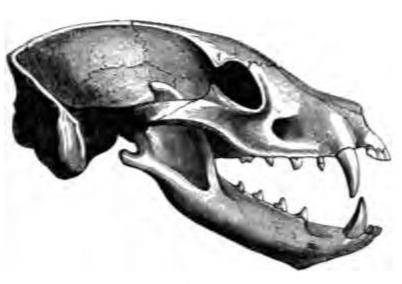|
Nilopegamys
The Ethiopian amphibious rat, also known as the Ethiopian water mouse (''Nilopegamys plumbeus''), is an insectivorous and semiaquatic species of rodent in the monotypic genus ''Nilopegamys'' of the family Muridae. There has only been one known specimen. It was found along the Lesser Abay River near its source at an altitude of 2600 m in the highlands of northwestern Ethiopia in 1928. ''N. plumbeus'' is considered to be the most aquatically adapted African murid; its unusually large brain is thought to be one consequence of this lifestyle. The species is considered to be critically endangered or possibly extinct, since its habitat has been severely damaged by overgrazing and monoculture. Distribution and discovery In late March 1928, the Ethiopian amphibious rat was cataloged for the first time. The specimen was discovered in a trap set by Wilfred H. Osgood, and was unlike any African rat he had seen before. The rat showed multiple adaptations to aquatic life which is uncommon f ... [...More Info...] [...Related Items...] OR: [Wikipedia] [Google] [Baidu] |
Mammals Of Ethiopia
This is a list of the mammal species recorded in Ethiopia. There are 279 mammal species in Ethiopia, of which five are critically endangered, eight are endangered, twenty-seven are vulnerable, and twelve are near threatened. The following tags are used to highlight each species' conservation status as assessed by the International Union for Conservation of Nature: Some species were assessed using an earlier set of criteria. Species assessed using this system have the following instead of near threatened and least concern categories: Order: Macroscelidea (elephant shrews) Often called sengis, the elephant shrews or jumping shrews are native to southern Africa. Their common English name derives from their elongated flexible snout and their resemblance to the true shrews. *Family: Macroscelididae (elephant-shrews) **Genus: ''Elephantulus'' *** Rufous elephant shrew, ''E. rufescens'' Order: Tubulidentata (aardvarks) The order Tubulidentata consists of a single species, the ... [...More Info...] [...Related Items...] OR: [Wikipedia] [Google] [Baidu] |
Old World Rats And Mice
The Old World rats and mice, part of the subfamily Murinae in the Family (biology), family Muridae, comprise at least 519 species. Members of this subfamily are called murines. In terms of species richness, this subfamily is larger than all mammal families except the Cricetidae and Muridae, and is larger than all mammal order (biology), orders except the bats and the remainder of the rodents. Description The Murinae are native to Africa, Europe, Asia, and Australia. They are terrestrial animal, terrestrial placental mammals. They have also been invasive species, introduced to all continents except Antarctica, and are serious pest animals. This is particularly true in island communities where they have contributed to the endangered, endangerment and extinction of many native animals. Two prominent murine species have become vital laboratory animals: the brown rat and house mouse are both used as medical subjects. The murines have a distinctive Molar (tooth), molar pattern th ... [...More Info...] [...Related Items...] OR: [Wikipedia] [Google] [Baidu] |
Wilfred Hudson Osgood
Wilfred Hudson Osgood (December 8, 1875 – June 20, 1947) was an American zoologist. Biography Osgood was born in Rochester, New Hampshire, the oldest child of a family of watchmakers. The family moved to California in 1888 and he went to study in Santa Clara, California, Santa Clara and San Jose, California, San Jose. He joined in the activities of the Cooper Ornithological Club and found company in wikisource:Author:Chester Barlow, Chester Barlow and Rollo Beck, Rollo H. Beck. He taught at a school in Arizona for a year and then moved to the newly formed Stanford University, where he came to meet Charles Henry Gilbert, Charles H. Gilbert and David Starr Jordan. He joined the staff of the Bureau of Economic Ornithology and Mammalogy, of the United States Department of Agriculture at the age of 22. This group later became the Bureau of Biological Survey under Clinton Hart Merriam. In 1909 he moved to the Field Museum of Natural History in Chicago, where he was assistant curator o ... [...More Info...] [...Related Items...] OR: [Wikipedia] [Google] [Baidu] |
Overgrazing
Overgrazing occurs when plants are exposed to intensive grazing for extended periods of time, or without sufficient recovery periods. It can be caused by either livestock in poorly managed agricultural applications, game reserves, or nature reserves. It can also be caused by immobile, travel restricted populations of native or non-native wild animals. Overgrazing reduces the usefulness, productivity and biodiversity of the land and is one cause of desertification and erosion. Overgrazing is also seen as a cause of the spread of invasive species of non-native plants and of weeds. Degrading land, emissions from animal agriculture and reducing the biomass in a ecosystem contribute directly to climate change between grazing events. Successful planned grazing strategies have been in support of the American bison of the Great Plains, or migratory wildebeest of the African savannas, or by holistic planned grazing. [...More Info...] [...Related Items...] OR: [Wikipedia] [Google] [Baidu] |
Endemic Fauna Of Ethiopia
Endemism is the state of a species being found only in a single defined geographic location, such as an island, state, nation, country or other defined zone; organisms that are indigenous to a place are not endemic to it if they are also found elsewhere. For example, the Cape sugarbird is found exclusively in southwestern South Africa and is therefore said to be ''endemic'' to that particular part of the world. An endemic species can also be referred to as an ''endemism'' or, in scientific literature, as an ''endemite''. Similarly, many species found in the Western ghats of India are examples of endemism. Endemism is an important concept in conservation biology for measuring biodiversity in a particular place and evaluating the risk of extinction for species. Endemism is also of interest in evolutionary biology, because it provides clues about how changes in the environment cause species to undergo range shifts (potentially expanding their range into a larger area or becomi ... [...More Info...] [...Related Items...] OR: [Wikipedia] [Google] [Baidu] |
Tumblr
Tumblr (pronounced "tumbler") is a microblogging and Social networking service, social networking website founded by David Karp in 2007 and is owned by American company Automattic. The service allows users to post multimedia and other content to a short-form blog. History Beginnings (2006–2012) Development of Tumblr began in 2006 during a two-week gap between contracts at David Karp's software consulting company, Davidville. Karp had been interested in microblogging, tumblelogs (short-form blogs, hence the name Tumblr) for some time and was waiting for one of the established blogging platforms to introduce their own tumblelogging platform. As none had done so after a year of waiting, Karp and developer Marco Arment began working on their own platform. Tumblr was launched in February 2007, and within two weeks had gained 75,000 users. Arment left the company in September 2010 to work on Instapaper. In June 2012, Tumblr featured its first major brand advertising campaign in ... [...More Info...] [...Related Items...] OR: [Wikipedia] [Google] [Baidu] |
Bucknell University
Bucknell University is a Private college, private Liberal arts colleges in the United States, liberal-arts college in Lewisburg, Pennsylvania, United States. Founded in 1846 as the University at Lewisburg, it now consists of the College of Arts and Sciences, the Freeman College of Management, and the College of Engineering. It offers 65 majors and 70 minors in the sciences and humanities. Located just south of Lewisburg, the campus rises above the West Branch Susquehanna River, West Branch of the Susquehanna River. Approximately 3,700 undergraduate students and 50 graduate students attend Bucknell. It is a member of the Patriot League in NCAA Division I athletics. Its athletic teams are the Bucknell Bison and its mascot is Bucky the Bison. History Founding and early years Founded in 1846 as the University at Lewisburg, Bucknell traces its origin to a group of Baptists from White Deer Valley Baptist Church who deemed it "desirable that a Literary Institution should be establish ... [...More Info...] [...Related Items...] OR: [Wikipedia] [Google] [Baidu] |
European Water Vole
The European water vole (''Arvicola amphibius'') or northern water vole is a semi-aquatic rodent. It is often informally called the water rat, though it only superficially resembles a true rat. Water voles have rounder noses than rats, deep brown fur, chubby faces and short fuzzy ears; unlike rats their tails, paws and ears are covered with hair. In the wild, on average, water voles only live about five months. Maximum longevity in captivity is two and a half years. Appearance Water voles reach in length, plus a tail which is about half the length of the body. Weights reported for adults are variable. It is possible for large, optimal adults to weigh as much as However, these are peak weights. Elsewhere, the mean body mass has been reported as , although this figure includes immature water voles. The minimum weight to successfully breed as well as to survive winter is reportedly in females and in males.Yavuz, Güliz, Ercüment Çolak, and Teoman Kankılıç. ''Investiga ... [...More Info...] [...Related Items...] OR: [Wikipedia] [Google] [Baidu] |
Marsh Rice Rat
The marsh rice rat (''Oryzomys palustris'') is a semiaquatic North American rodent in the family Cricetidae. It usually occurs in wetland habitats, such as swamps and salt marshes. It is found mostly in the eastern and southern United States, from New Jersey and Kansas south to Florida and northeasternmost Tamaulipas, Mexico; its range previously extended further west and north, where it may have been a commensalism, commensal in corn-cultivating communities. Weighing about , the marsh rice rat is a medium-sized rodent that resembles the common black rat, black and brown rat. The upperparts are generally gray-brown, but are reddish in many Florida populations. The feet show several specializations for life in the water. The skull is large and flattened, and is short at the front. John Bachman discovered the marsh rice rat in 1816, and it was formally described in 1837. Several subspecies have been described since the 1890s, mainly from Florida, but disagreement exists over their ... [...More Info...] [...Related Items...] OR: [Wikipedia] [Google] [Baidu] |
Habitat Loss
Habitat destruction (also termed habitat loss or habitat reduction) occurs when a natural habitat is no longer able to support its native species. The organisms once living there have either moved elsewhere, or are dead, leading to a decrease in biodiversity and Abundance (ecology), species numbers. Habitat destruction is in fact the leading cause of biodiversity loss and species extinction worldwide. Humans contribute to habitat destruction through the Exploitation of natural resources, use of natural resources, agriculture, industrial production and urbanization (urban sprawl). Other activities include mining, logging and trawling. Environmental factors can contribute to habitat destruction more indirectly. Geological processes, climate change, introduced species, introduction of invasive species, ecosystem nutrient depletion, water pollution, water and noise pollution are some examples. Loss of habitat can be preceded by an initial habitat fragmentation. Fragmentation and lo ... [...More Info...] [...Related Items...] OR: [Wikipedia] [Google] [Baidu] |
Insectivorous
A robber fly eating a hoverfly An insectivore is a carnivorous animal or plant which eats insects. An alternative term is entomophage, which can also refer to the human practice of eating insects. The first vertebrate insectivores were amphibians. When they evolved 400 million years ago, the first amphibians were piscivores, with numerous sharp conical teeth, much like a modern crocodile. The same tooth arrangement is however also suited for eating animals with exoskeletons, thus the ability to eat insects can stem from piscivory. At one time, insectivorous mammals were scientifically classified in an order called Insectivora. This order is now abandoned, as not all insectivorous mammals are closely related. Most of the Insectivora taxa have been reclassified; those that have not yet been reclassified and found to be truly related to each other remain in the order Eulipotyphla. Although individually small, insects exist in enormous numbers. Insects make up ... [...More Info...] [...Related Items...] OR: [Wikipedia] [Google] [Baidu] |








